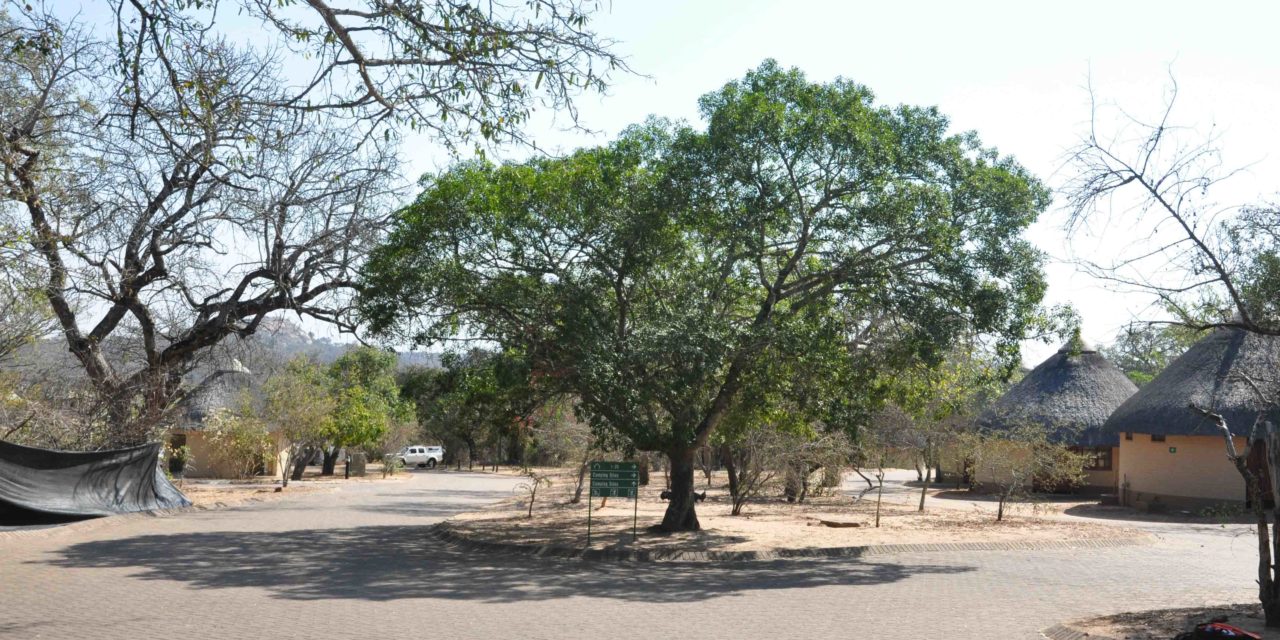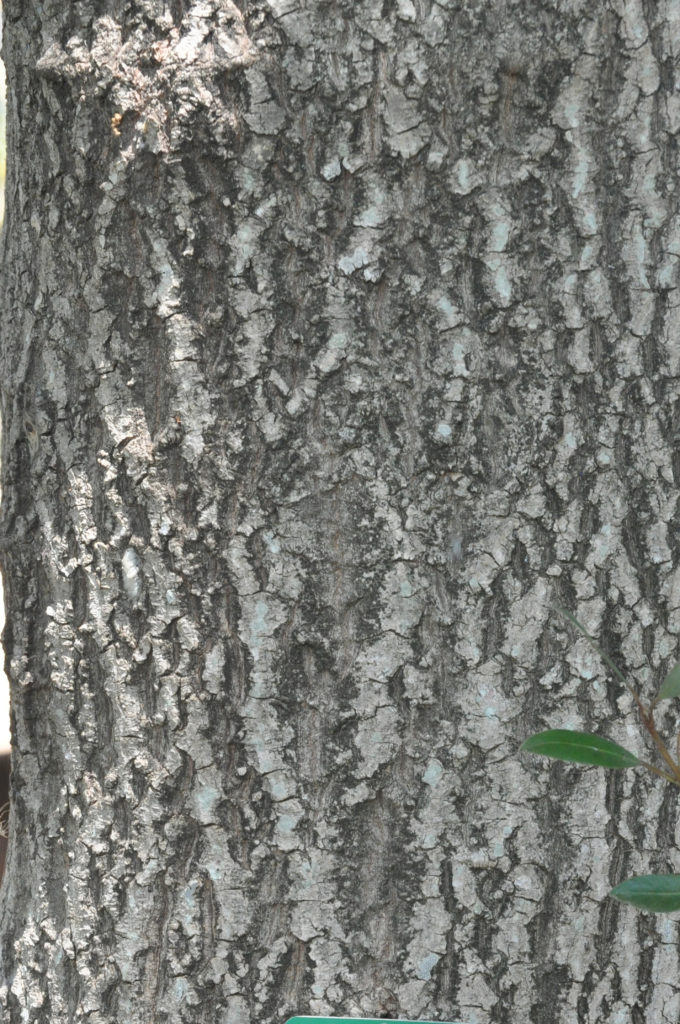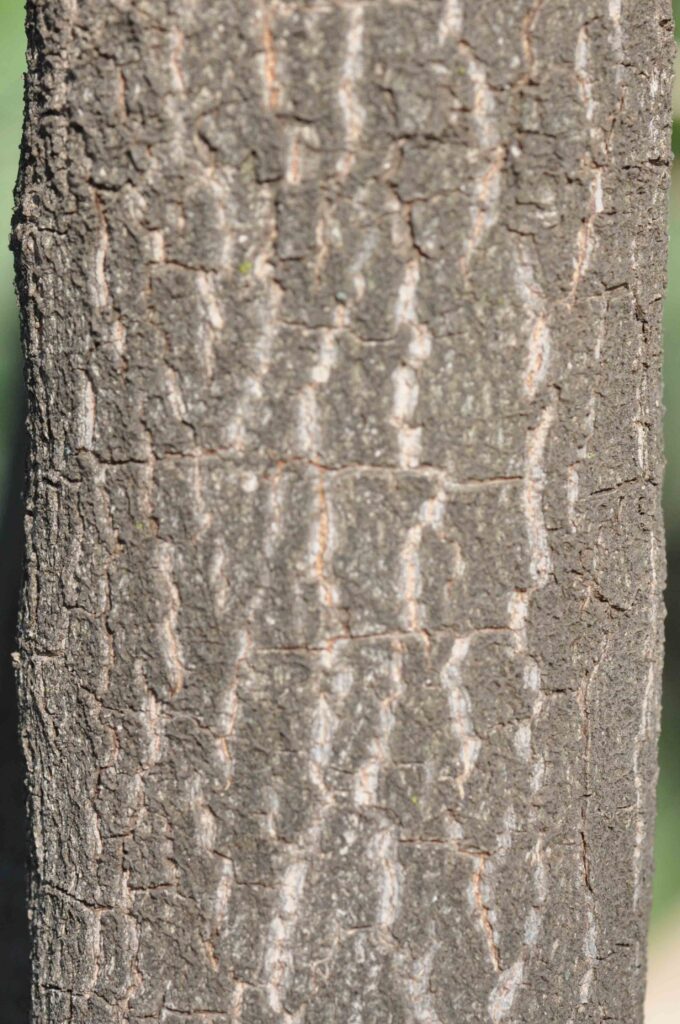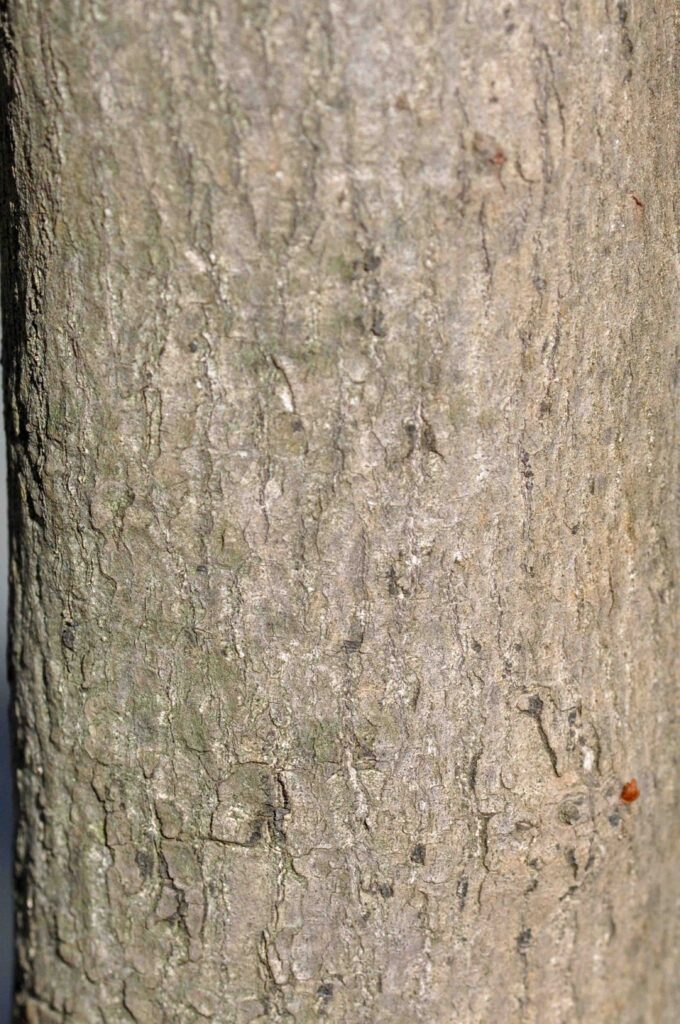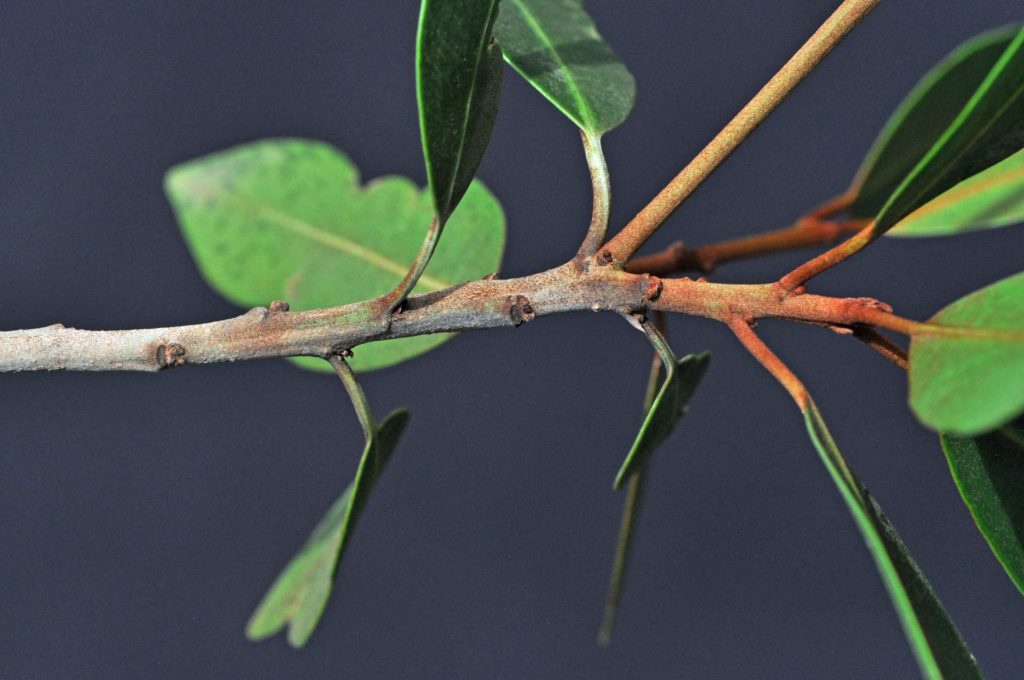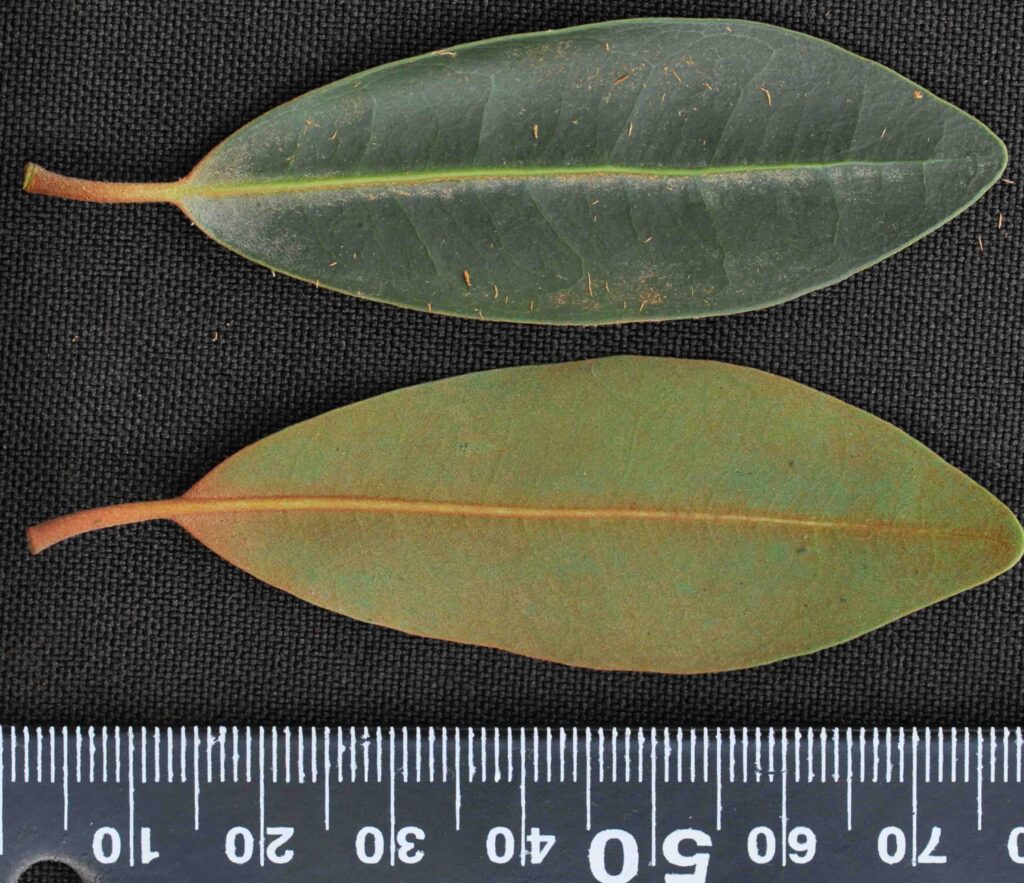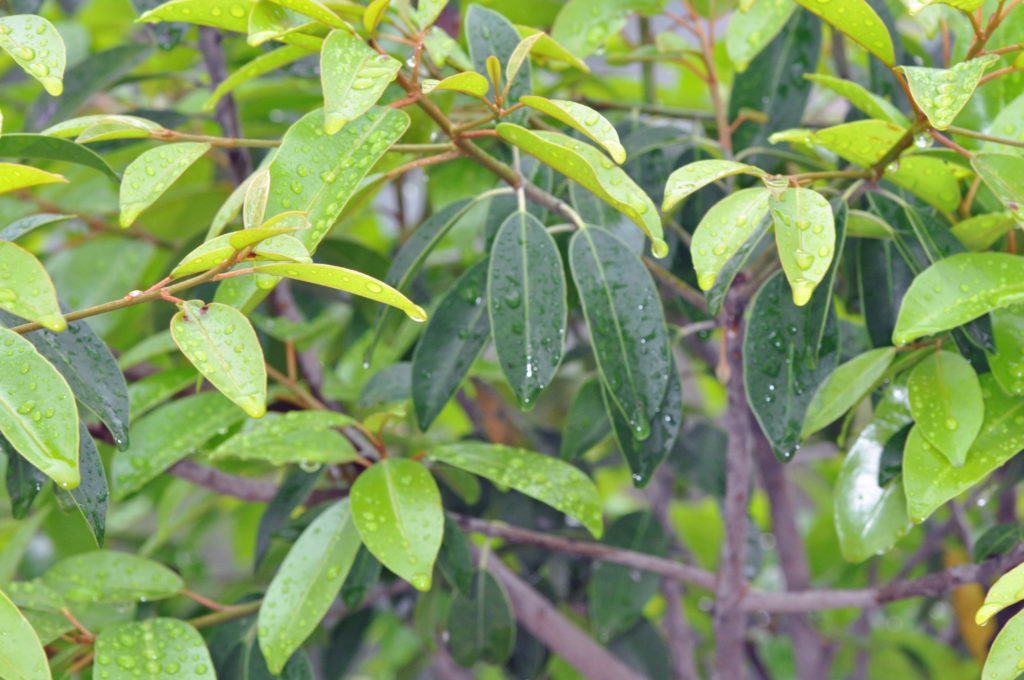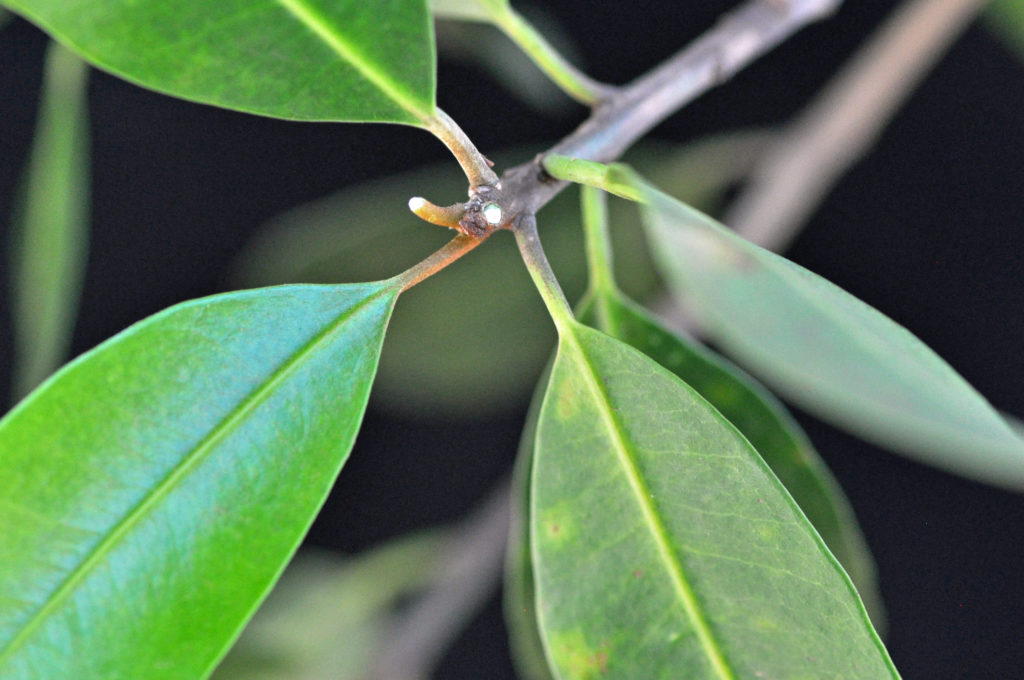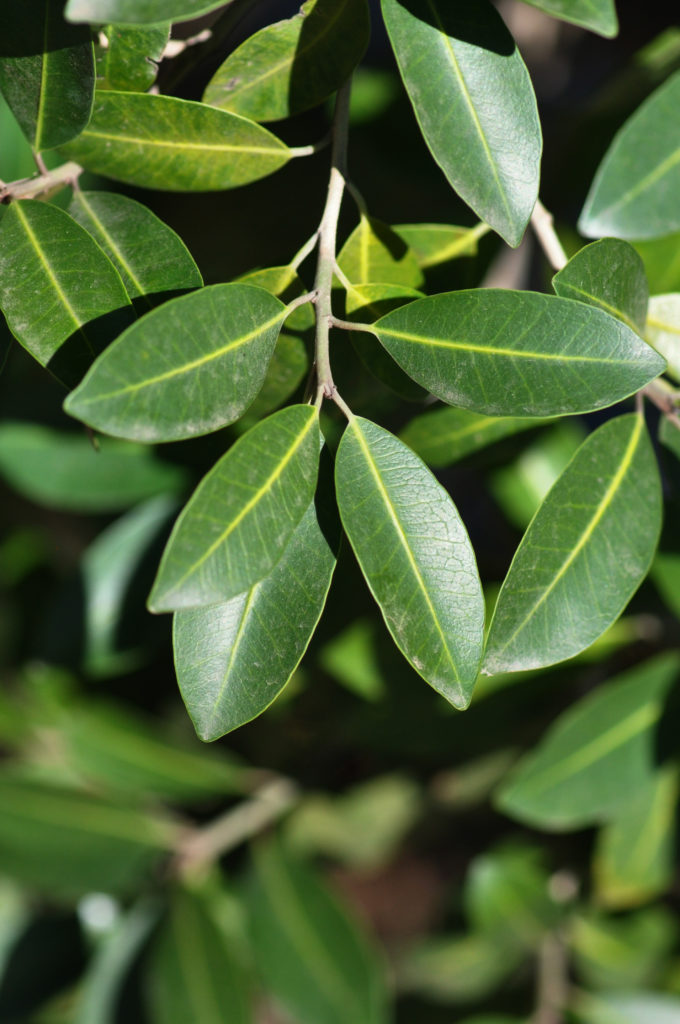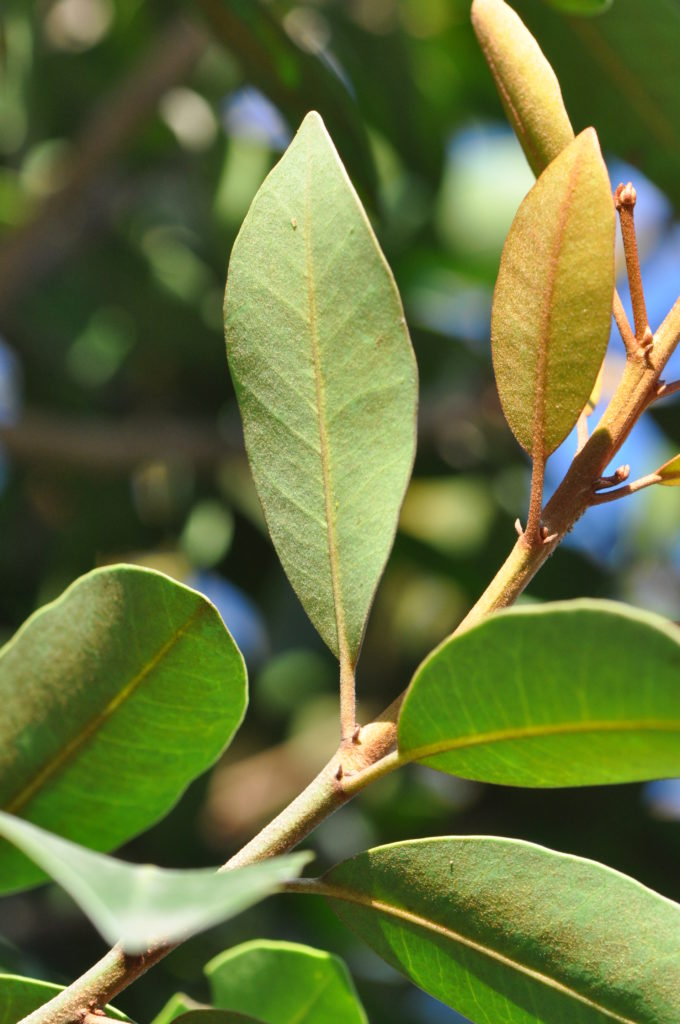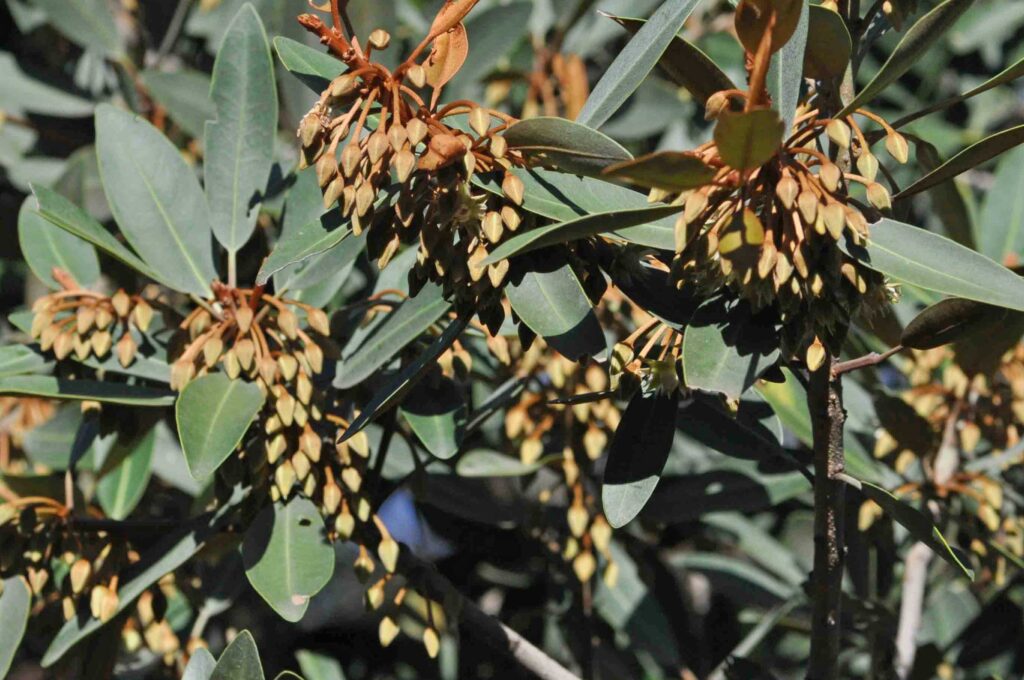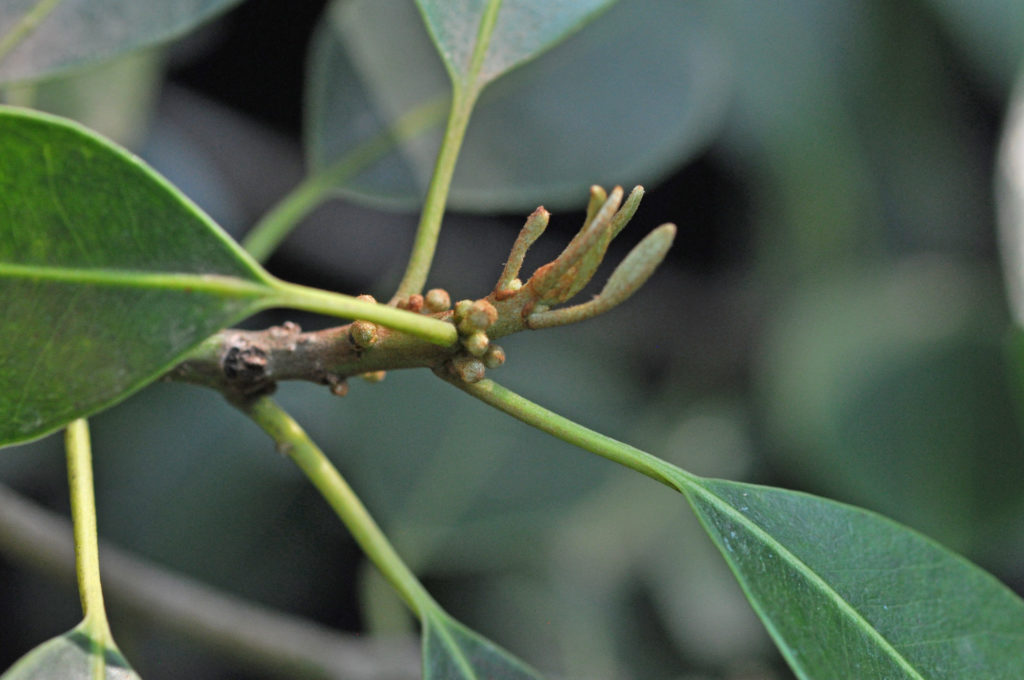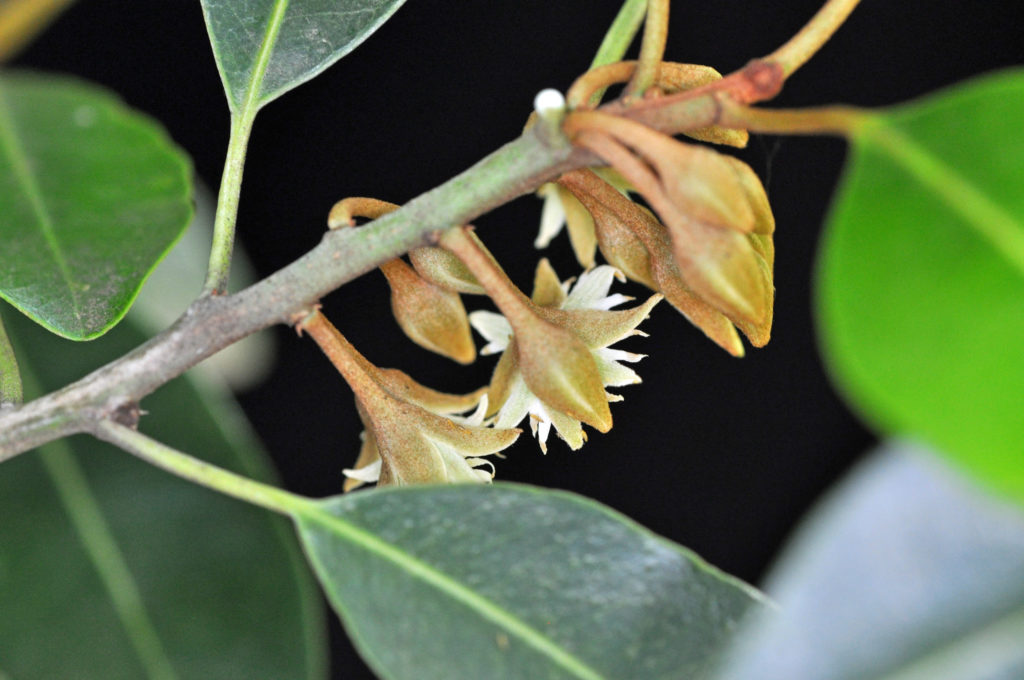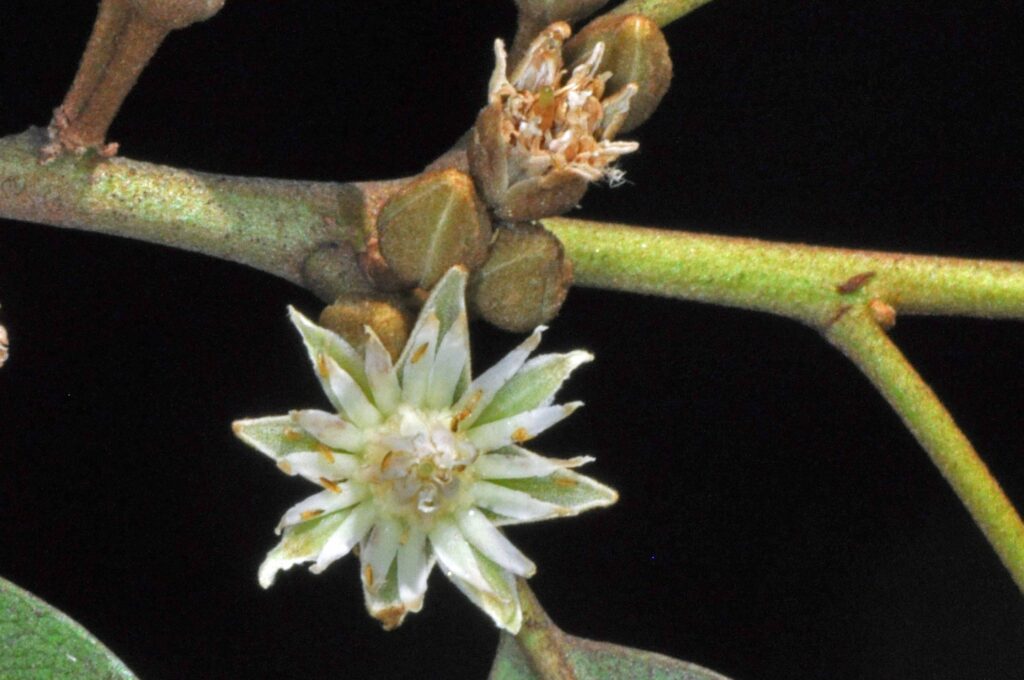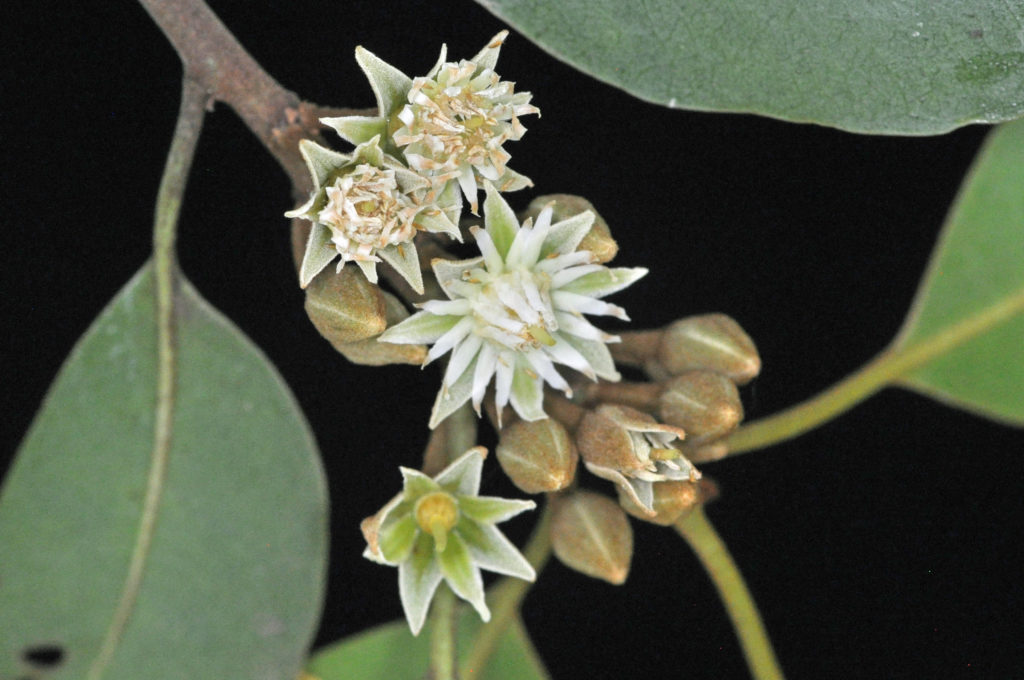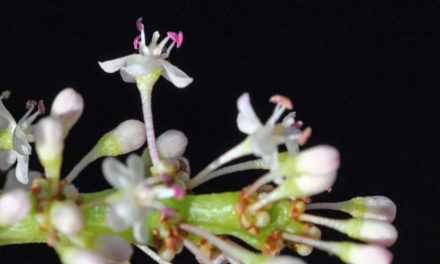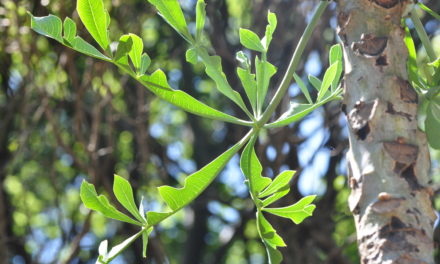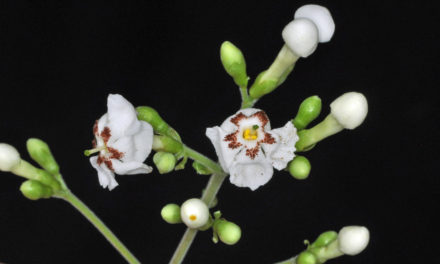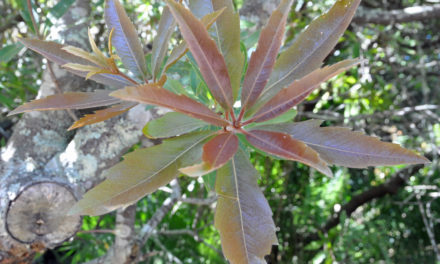General Info – summary
This dense shady, smallish Tree with a straight trunk is up to 15m high. Damaged parts yield milky latex. Leathery, simple, alternate/spiral Leaves are entire. Small, white, star-shaped Flowers are 4-merous, bisexual, actinomorphic, and develop on a red hairy pedicel. 8 stamens, 8 staminodes &, a single pistil with a superior ovary & a single style develop. Yellow Fruit: a fleshy berry with a single shiny seed.
Description
Mimusops zeyheri
Previous Names: Mimusops decorifolia, Mimusops monroi, Mimusops zeyheri var. laurifolia.
SA Tree No. 585.
Common names: (Afr) Moepel, Rooimelkhout, Transvaalmelkhout. (Eng) Common Red-milkwood, Red-milkwood, Red Milkwood, Transvaal Red Milkwood, Northern Red Milkwood. (isiNdebele) Umbumbulu. (isiZulu) Umkhele, Umphusane, Umpushane. (Northern Sotho) Mmupudu. (Setswana) Nhlantswa. (siSwati) Umphusane, Umpushane. (Tshivenda) Mububulu, Mutaladzi.
Family: Sapotaceae. (Stamvrug, latex-yielding family). This family includes 35-75 genera and approximately 800 species. Local genera with trees on this website include Englerophytum, Inhambanella, Mimusops, Sideroxylon and Vitellariopsis. Branches exude latex. Leaves are simple, entire and there are closely parallel secondary veins. Stipules are absent. Flowers are bisexual, usually actinomorphic (regular). There are persistent Sepals and fused Petals. The Stamens equal the number petals. Staminodes may be present outside the fertile stamens. The superior Ovary has locules containing a single ovule. One Style and 1 Stigma are present. Fruit is a berry. Seeds have a thick brown shiny testa (seed coat) with a distinct scar. There are 7 genera and 14 species in southern Africa.
Name derivation: Mimusops (resembling an ape – unusual!). zeyheri – honours the botanist who discovered the tree: Carl L. P. Zeyheri (1799-1858). He visited South Africa from 1822 and collected plant specimens in Gauteng, Free State and the Eastern and Western Cape. His specimens formed the basis of Floral Capensis – (a systematic description of the plants of the Cape colony, Eastern Cape, & Port Natal (and neighboring territories).
Conservation: National Status: L C. (Least Concern). Assessed: L. von Staden – 2017.
Tree
This usually small shady Tree with a long straight stem has spreading branches – even close to the ground, resulting in a dense rounded crown (intro photo) up to 6m and occasionally 15m high. It may also be twisted and short. The spread of the crown may equal or exceed the height of the tree (intro photo). Twigs (1-year-old current branch segments) are knobbly. Reddish, appressed (closely and flatly pressed against but not joined) Hairs are present on new growth (photo 308). In this photo, leaf scars are visible. The Trunk is usually long and straight but can be short, twisted and even forked. Old trunks may be hollow. Milky latex is present. The Bark is grey, dark brown to blackish (photos 658 to 528) and rather smooth when young (photo 840). On older trunks, bark is lengthwise cracked or deeply fissured (photo 528).
- 528. 2014/09/08. Lower Sabi KNP. Photo: David Becking.
- 658. 2015/04/21. Walter Sisulu NBG. Photo: David Becking.
- 840. 2014/11/25. Walter Sisulu NBG. Photo: David Becking.
- 308. 2018/01/11. Walter Sisulu NBG. Photo: David Becking.
Leaves
On this evergreen tree, the elliptic, oblong, obovate-elliptic or even lanceolate Leaves are thinly leathery and simple (has a single blade, which may have incisions that are not deep enough to divide the blade into leaflets). They are up to 11 x 5,5cm (photo 548), arranged alternatively or spirally (photo 22) and usually broadest near the centre. Leaves are not densely crowded at branch ends. The Blade is initially light green (photo 576) but matures to a glossy dark green above and paler green below (photo 548). Fine Lateral Veins are present and more visible below. Young leaves and are reddish, due to the presence of a fine layer of dense red hairs (photo 656). These dense rusty hairs are soon lost and leaves change to light green and finally darker green (photo 576). The Midrib is slightly ridged above and more prominent below. The Apex (photos 22 & 656) is bluntly pointed or tapers to a pointed tip/or rounded and may be slightly notched. The Base is narrowly tapering. The rolled under, wavy Margin is slightly thickened (photo 739) and entire (with a continuous margin, not in any way indented). The Petiole (leaf stalk) may be reddish (photo 548) and up to 3cm long. Broken off leaves exude a milky latex (photo 739). Stipules (basal appendages of the petiole) may be present (photo 656).
- 548. 2019/11/25. Hope Springs Eternal. Photo: David Becking.
- . 576. 2014/11/11. Walter Sisulu NBG. Photo: David Becking.
- 739. 2015/11/10. Walter Sisulu NBG. Photo: David Becking.
- 22. 2014/04/29. Walter Sisulu NBG. Photo: David Becking.
- 656. 2015/04/21. Walter Sisulu NBG. Photo: David Becking.
Flowers
The star shaped, sweet scented, small (up to about 1cm in diameter), often numerous Flowers (photo 507) are bisexual and actinomorphic (Regular, symmetrical. Flowers are vertically divisible into similar halves by more than 1 plane passing through the axis). The white to cream flowers occur singly or are clustered in axillary groups of 1-7 in the leaf axils (photo 16). The Pedicel (stalk of a single flower) is curved, reddish, up to 3cm long and hairy (photo 08). Flower parts are 4-merous. The Calyx has 8 Sepal lobes in 2 whorls that are divided nearly to the base. In the bud, only the outer 4 are visible and these are rusty-red to greyish (photo 07). The Corolla has 8 white Petal lobes, and each lobe has 2 dorsal appendages. The usually 8 Stamens arise from the throat of the corolla tube. Their Filaments are shorter than the lanceolate, apiculate (ending in a short, sharp, flexible point) Anthers. Eight Staminodes (sterile stamens) are present. The single Pistil (a unit of the Gynoecium, the female element of the flower, composed of the Ovary, Style and Stigma) contains a superior, 8 locular Ovary with an Ovule in each locule. The single Style is slender (photo 07). (Oct-Mar).
- 507. 2019/11/25. Hope Springs Eternal. Photo: David Becking.
- 526. 2016/09/27. Walter Sisulu NBG. Photo: David Becking.
- 08. 2015/11/24. Walter Sisulu NBG. Photo: David Becking.
- 016. 2015/11/24. Walter Sisulu NBG. Photo: David Becking.
- 07. 2015/11/24. Walter Sisulu NBG. Photo: David Becking.
Fruit
The mature ovoid, fleshy Fruit is a Berry with orange pulpy indehiscent fruit – like a grape or tomato that is up to 3 x 2,5cm. A persistent, slightly spreading Calyx is present. Each brittle skinned fruit has milky latex and a pointed tip. Young berries are initially green and covered with tiny white dots. Each berry has a persistent calyx and becomes bright yellow at maturity. A persistent bristle like style may still be visible. Berries usually develop a single, shiny brown Seed that is up to 2cm long, has a basal circular scar and thin Cotyledons (primary leaves in the embryo. The Endosperm (the starch and oil-containing tissue of many seeds; often referred to as the albumen) is conspicuous. (Apr-Sep).
Distribution & Ecology
These Trees need a reasonable amount of summer rainfall. They are common in savannah (a rolling grassland scattered with shrubs and isolated trees, which can be found between a tropical rainforest and desert biome), woodland, bushveld (a sub-tropical woodland ecoregion of southern Africa), in hot areas close to streams and rivers – up to an altitude of 1 600m. They also occur on rocky outcrops and dry wooded hillsides. The trees can survive moderate frost and reach greater heights with a steady water supply. The Leaves provide a dense shade, which decreases the number of other plants from growing underneath. The animals that consume the fruit disperse seeds. Provinces where the tree occur include Gauteng, North West e.g., Hartbeespoort Dam and Magaliesberg (where it was first collected), Mpumalanga, Far Northern KwaZulu-Natal, and Limpopo e.g., Waterberg district. It is also found in Botswana, Angola, Swaziland, Mozambique, Zimbabwe (e.g., at the Great Zimbabwe medieval city situated near Masvingo in the south-eastern hills), and northwards into tropical Africa, including Tanzania.
Larvae of the Butterflies Boisduval’s False Acraea (Pseudacraea boisduvali) and the False Chief (Pseudacraea lucretia) feed on the Leaves. Monkeys, baboons and bushpigs eat leaves and elephants eat the leaves and Branches. Pigeons (Green and Rameron or African olive pigeon) and barbets eat the fruit. This tree may occur together with Englerophytum magalismontanum (Transvaal Milkplum or Stamvrug).
Ethnobotany
The pinkish green Wood dries to a beige-brown colour. It is reasonably hard, light, has a wavy grain and is useful when great strength is not required. Fumes from cutting green wood can causes sneezing. The Fruit has an orange flesh that is edible: pleasant, sweet tasting, flowery and has a reasonably high vitamin C content. Fresh Seeds germinate within a couple of weeks. Transplant seedlings during the following spring. Plants do best at medium to low altitudes in summer rainfall areas where the drainage is good. Adult trees can tolerate mild frost. These plants are used for bonsai.
References
Boon, R. 2010. Pooley’s Trees of eastern South Africa. Flora and Fauna Publications Trust, Durban.
Burrows, J.E., Burrows, S.M., Lotter, M.C. & Schmidt, E. 2018. Trees and Shrubs Mozambique. Publishing Print Matters (Pty) Ltd. Noordhoek, Cape Town.
Coates Palgrave, M. 2002. Keith Coates Palgrave Trees of Southern Africa, edn 3. Struik, Cape Town.
Ginn, P.J. McIlleron, W.G. Milstein, S. 1989. The Complete Book of Southern African Birds. Struik Publishers (PTY) LTD. Third impression 1991.
Lawrence, G. H. M, 1951. Taxonomy of Vascular Plants, The Macmillan Company, New York. Tenth Printing 1965.
Palmer, E. & Pitman, N. 1972. Trees of southern Africa, Balkema, Amsterdam, Cape Town.
Schmidt, S. Lotter, M. & McCleland, W. 2002. Trees and Shrubs of Mpumalanga and the Kruger National Park.
van Wyk, B. & van Wyk, P. 1997 Field guide to Trees of Southern Africa, Struik, Cape Town.
von Staden, L. 2017. Mimusops zeyheri Sond. National Assessment: Red List of South African Plants version 2020.1. Accessed on 2023/09/13.
Woodhall, S. 2020. Field Guide to Butterflies of South Africa, edn 2. Donnelley, RR, China.
https://en.wikipedia.org/wiki/Mimusops_zeyheri
http://www.botany.hawaii.edu/faculty/carr/sapot.htm

